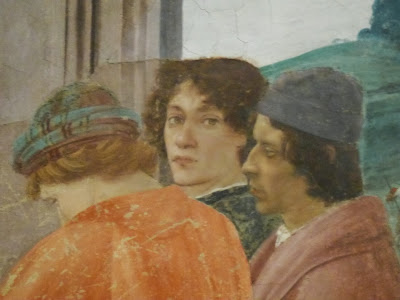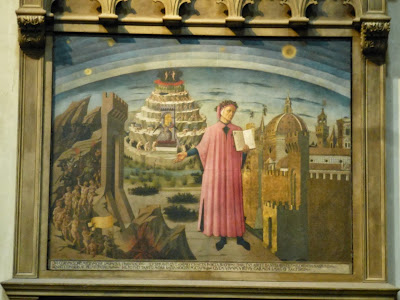Thursday was a big day for us. Rain was forecast, so we decided it would be well to be indoors, mostly at the Uffizi. But we stopped on the way at perhaps our favorite Florence site, the Brancacci Chapel in Santa Maria del Carmine. I blogged about it in 2011 at:
http://roadeveron.blogspot.it/2011/06/brancacci-chapel.html. If you're interested in art history, there are few more important places where you can see great change
in situ. Masolino, his pupil Masaccio, and, fifty years later, Filipino Lippi labored on the walls of this chapel, but the most stunning of the work, and the one to whom credit is generally given (as co-founder of the renaissance in visual arts), is Masaccio. It's right up there with the Arena (Scrovegni) Chapel. Below are just a few clarifications and embellishments on the former post.
 |
Self-portrait time: of the four on top, the
short guy is Masolino, nevermind the guy
looking at you, the fair-headed one is
Massacio, and the hooded guy is Brunelleschi;
Brunelleschi's mathematical theories of
linear perspective informed Masaccio's
painting, and much else; Donatello was the
third member of this group; they actually
made a road trip to Rome together, which one
might fancifully argue was the beginning of
the renaissance in art; just FYI |
 |
Definitely Italy, or possibly Spain, with laundry hanging out
the windows; oh, that's St. Peter with the halo (the Chapel
is mostly about him) |
 |
On-lookers at St. Peter's crucifixion; the one looking at you
is Botticelli, done by his friend and pupil, Lippi |
 |
Michaelangelo was sitting just about here, sketching St. Peter's
raising of Theophilus' son from the dead, when Torrigiano
cold-cocked him, breaking his nose; they were having a discussion
about Torrigiano's drawing skills... |
 |
| Peter and Simon the Magician disputing before Nero; a personal favorite |




























.jpg)




.jpg)



















